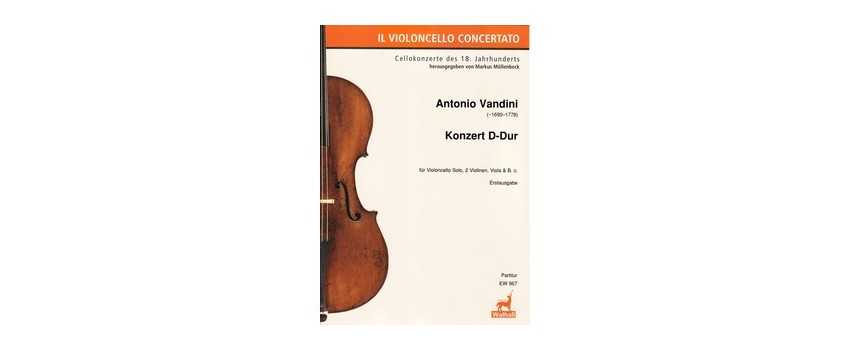Vandini, 2 Sonatas For Cello (Schott)
NOTE 20/09/21 - CURRENTLY OUT OF STOCK AND UNAVAILABLE FROM SUPPLIER. PLEASE CALL US TO ENQUIRE
Antonio Vandini, born in 1691 in Bologna, Italy, was a renowned cellist and composer of the Baroque era. He is best known for his exceptional virtuosity on the cello and his close friendship with Giuseppe Tartini, another prominent Italian composer. Vandini's musical career revolved around his position as the first violoncellist of the "Veneranda Arca" at the Basilica del Santo in Padua, where Tartini served as the first violinist and concertmaster.
Early Life and Musical Training
Little is known about Vandini's early life and musical training. His first documented playing position was at the church of Santa Maria Maggiore in Bergamo, which he obtained in April 1720. During this time, he also served as the Maestro di violoncello at the Ospedale della Pietà in Venice. Vandini's talent and skill as a cellist likely led him to perform extensively throughout northern Italy during this period.
The Padua Years
In June 1721, Vandini secured the solo cello position in Padua, a role he would hold for the majority of his career. While in Padua, he collaborated with notable musicians such as oboist Matteo Bissoli and organist and Maestro di capella Antonio Vallotti. Vandini's performances with the Veneranda Arca took him on tours across Italy, including appearances in Assisi and Rome.
English traveler and musical critic Charles Burney attended a mass at the Basilica in Padua in 1770 and left a vivid description of Vandini's playing style: "the famous old Antonio Vandini, on the violoncello, who, the Italians say, plays and expresses a parlare, that is, in such a manner as to make his instrument speak." Vandini's expressive and rhetorical playing was highly regarded, and he was known for his ability to evoke speech through his cello. He was also praised for his technical prowess, as he was one of the first composers to write music that required the use of thumb position.
Works and Compositions
Vandini's musical legacy is preserved through his surviving works, which are found in manuscript copies throughout Europe, including Venice, Berlin, Paris, and Schwerin. His compositions exemplify the galant style that was popular in eighteenth-century Italy. It is worth noting that two short sonatas attributed to Vandini by Carl Schroeder in 1911 and published by Schott are considered spurious and do not reflect his style.
Here is a list of Vandini's works, with the proposed catalogue numbers by Elinor Frey and Marc Vanscheeuwijk:
Sonata a Violoncello solo del Signor D. Antonio Vandini, in C Major (1717, I-Vnm, Mss. It.IV.1095) (Van. 1)
Sonata del Signor D. Antonio Vandini, in C Major (D-B, KHM 5528) (Van. 2)
Sonata Del Signor D. Antonio Vandini, in B-flat Major (1730, F-Pn, VM7-6285) (Van. 3)
Sonata Del Signor D. Antonio Vandini, in A Minor (1730, F-Pn, VM7-6285) (Van. 4)
Concerto Del Signor D. Antonio Vandini, in D Major (D-SWI Mus. 4736/4) (Van.5)
Sonata a Violoncello Del Signor D. Antonio Vandini, in B-flat Major (D-B, KHM 5527) (Van. 6)
Sonata a Violoncello e Basso Del Signor D. Antonio Vandini, in E Major (D-B, KHM 5529) (Van. 7)
Legacy and Influence
Antonio Vandini's contributions to the world of music cannot be overstated. As one of the foremost virtuoso performers of his time, his expressive and technical abilities set him apart. His friendship with Giuseppe Tartini and their collaborations in Padua enriched the musical landscape of the era. Vandini's compositions, though relatively few in number, showcase his mastery of the cello and the galant style prevalent during the Baroque period.
Today, Vandini's works continue to be studied and performed by cellists and music enthusiasts worldwide. His expressive playing style and innovative use of thumb position have left an indelible mark on the art of cello playing. Vandini's legacy as a virtuoso cellist and composer lives on, ensuring that his contributions to the world of music will be remembered for generations to come.

NOTE 20/09/21 - CURRENTLY OUT OF STOCK AND UNAVAILABLE FROM SUPPLIER. PLEASE CALL US TO ENQUIRE